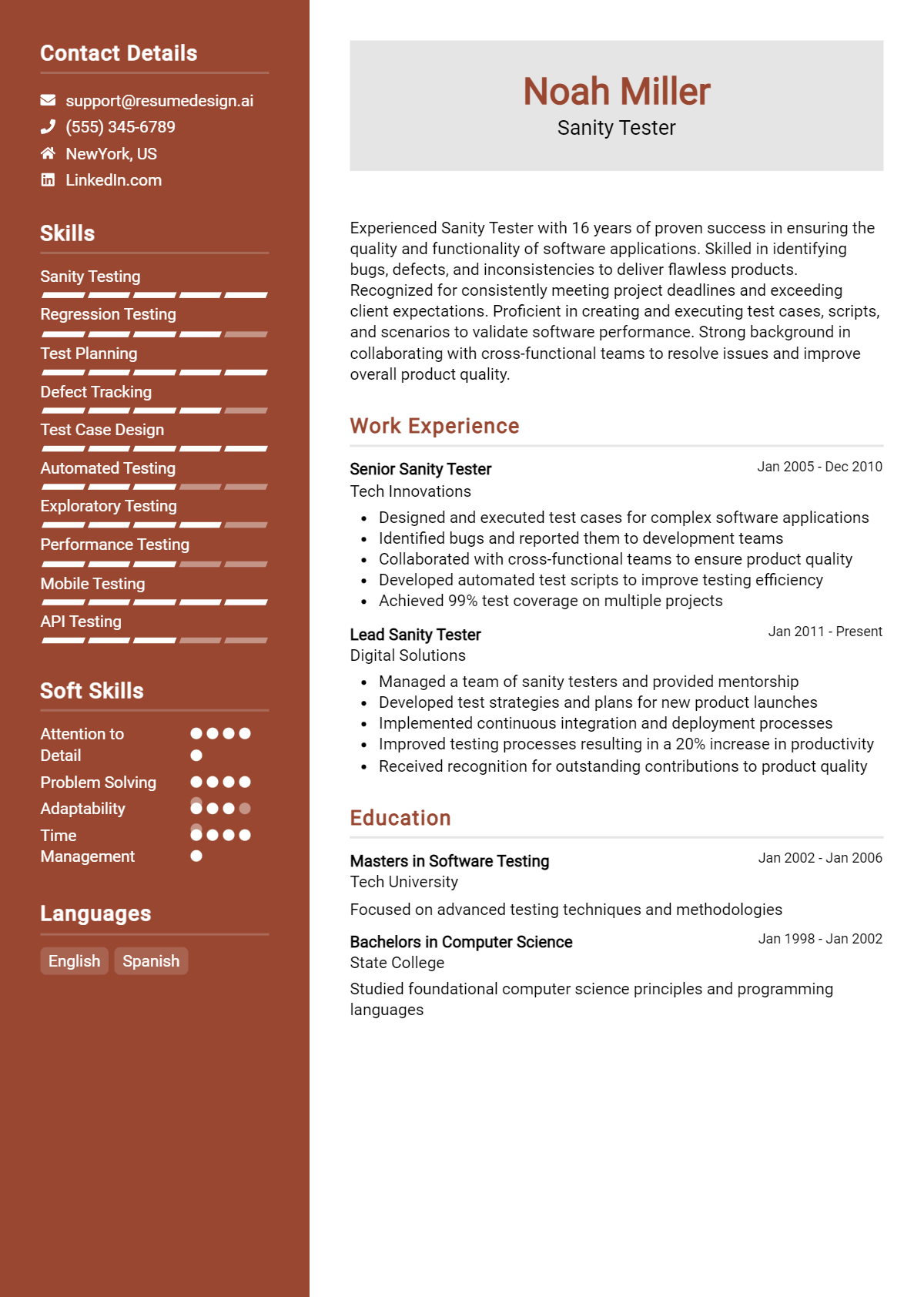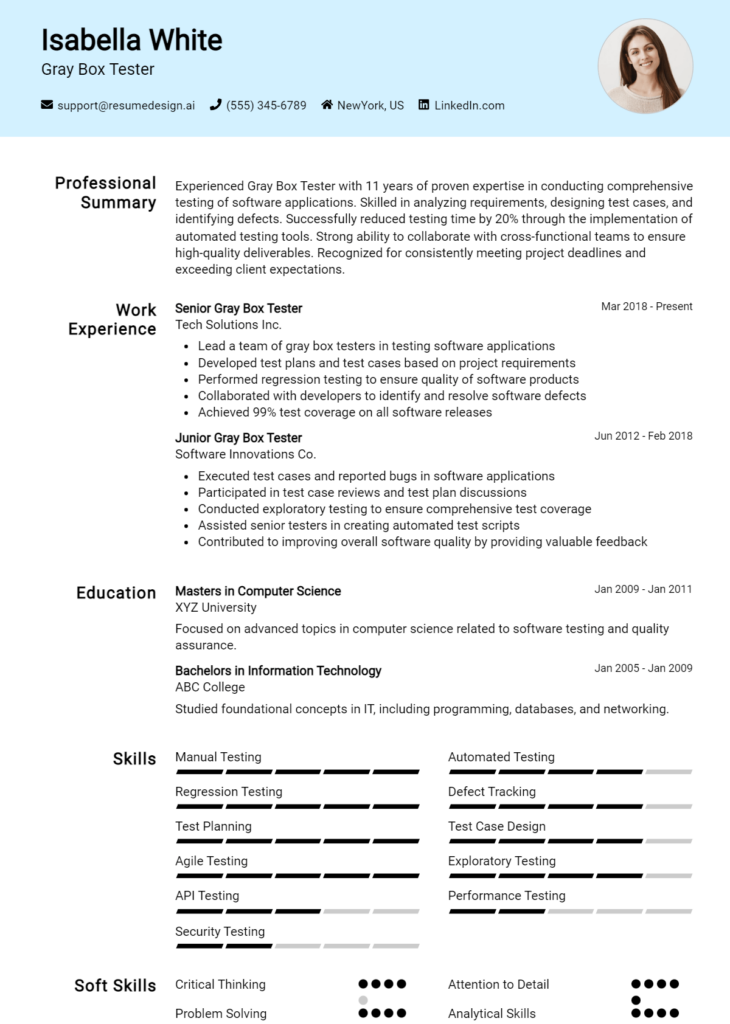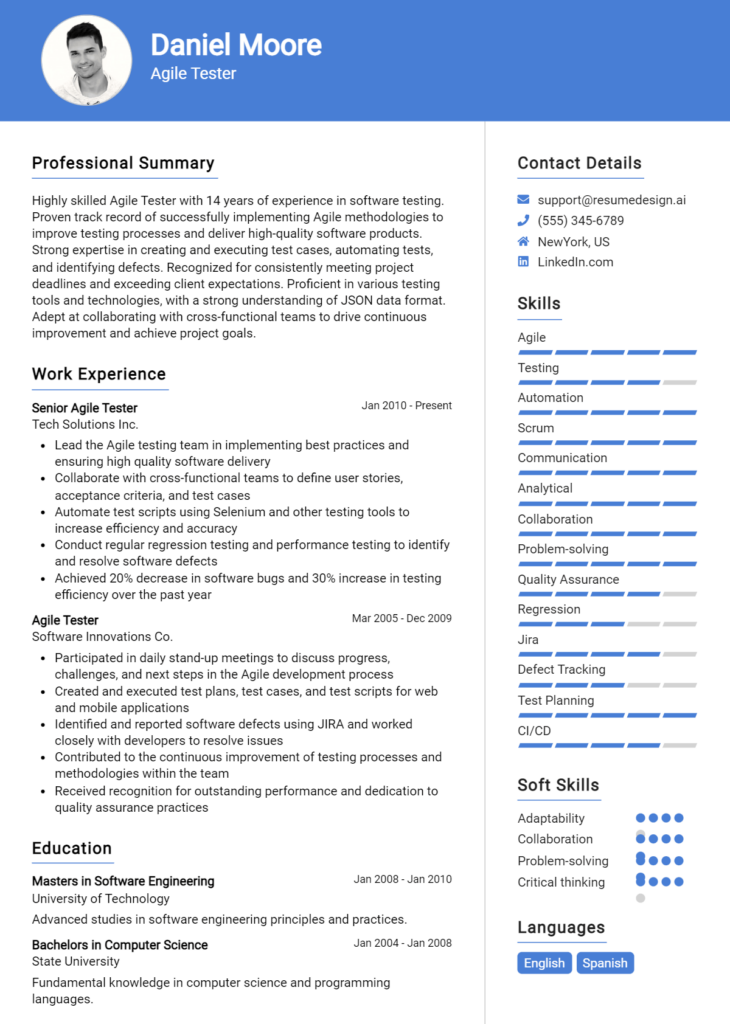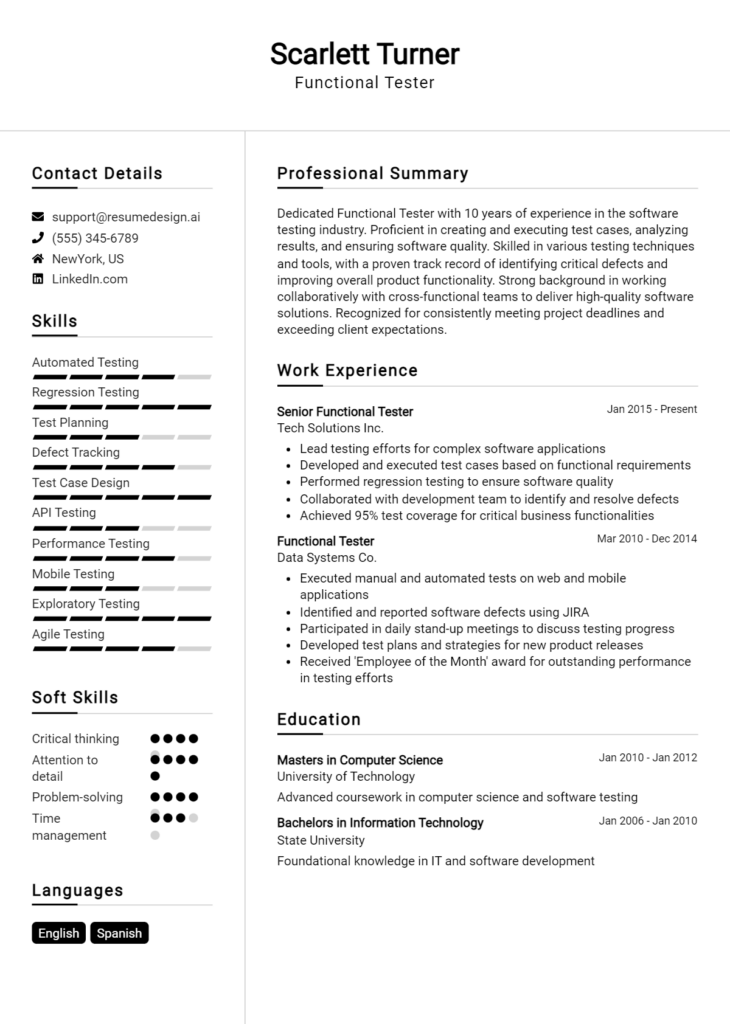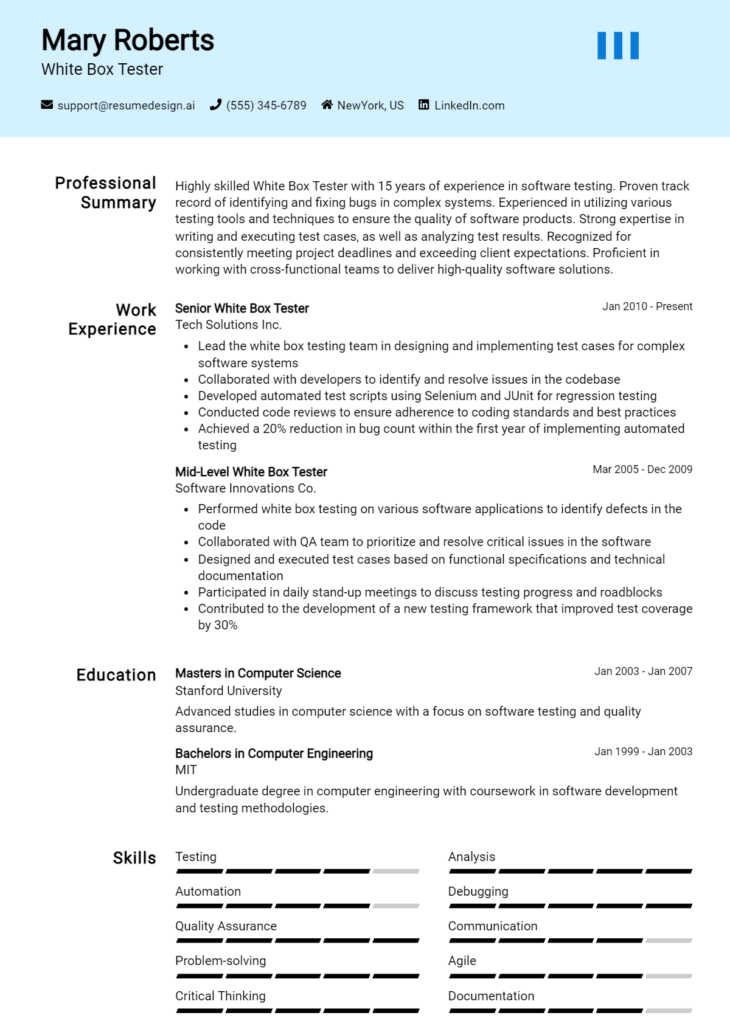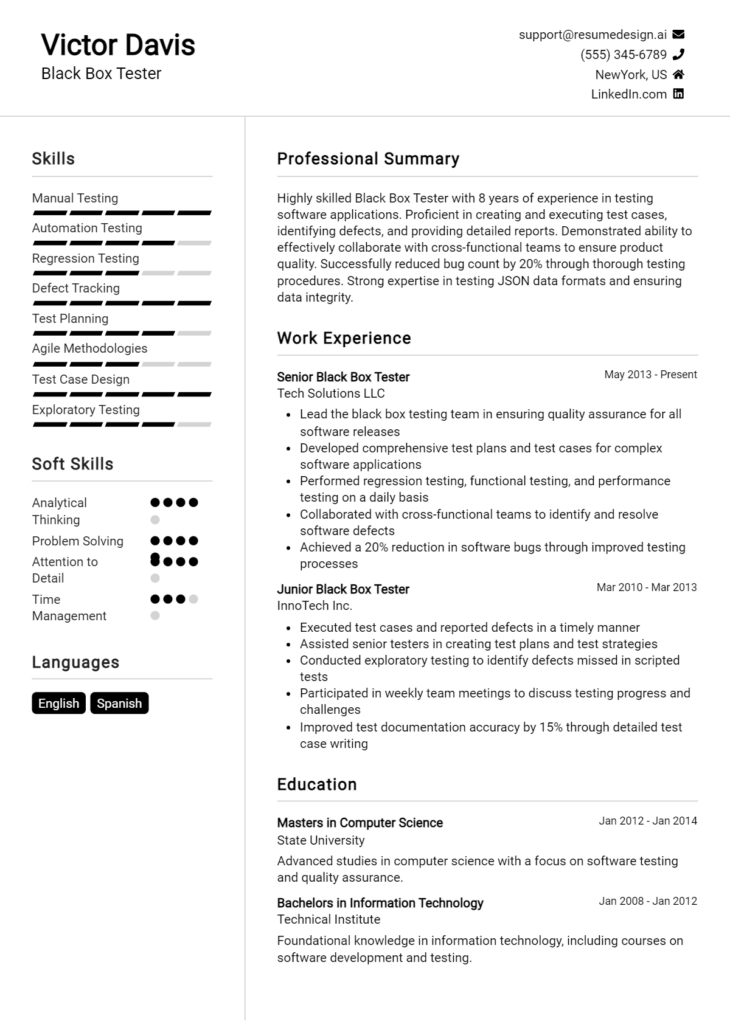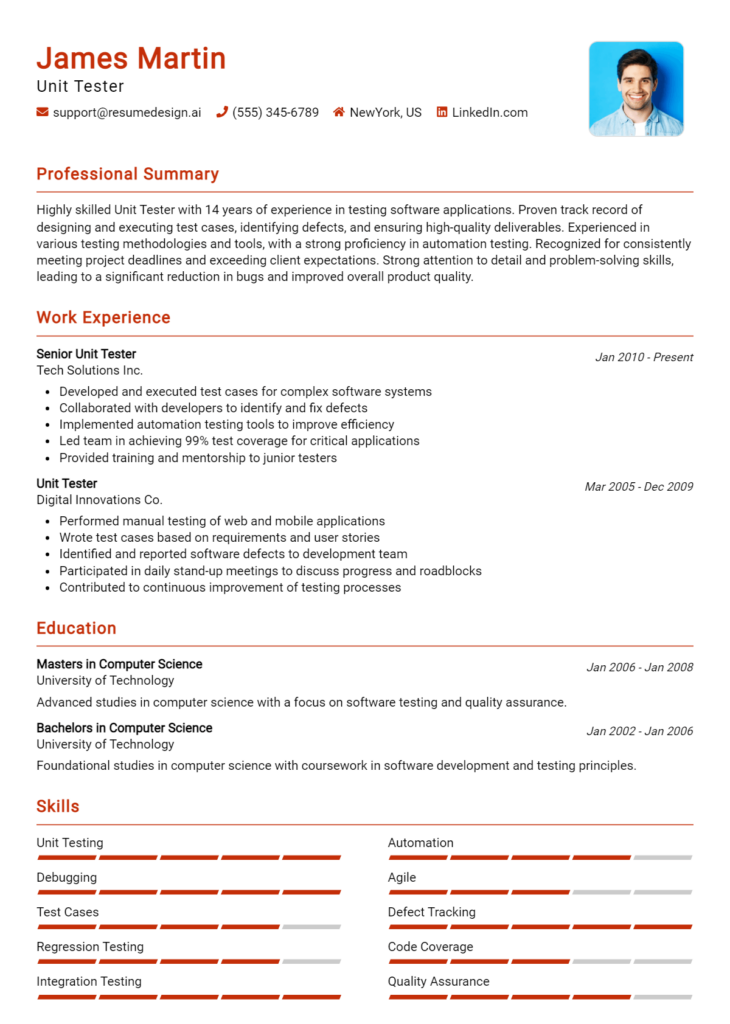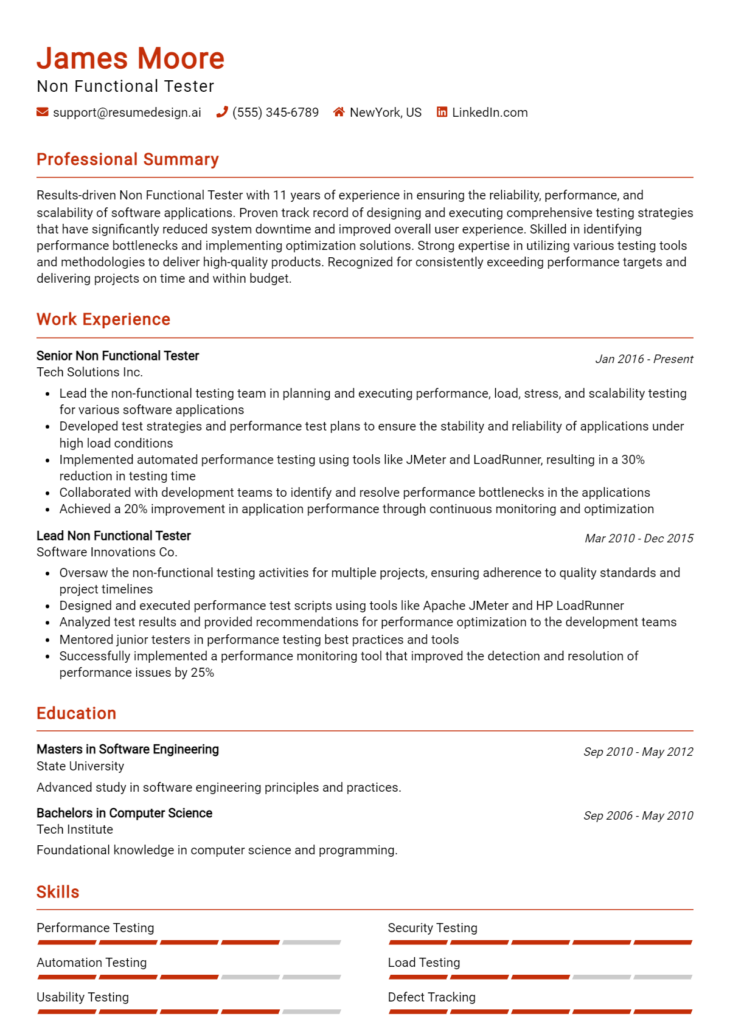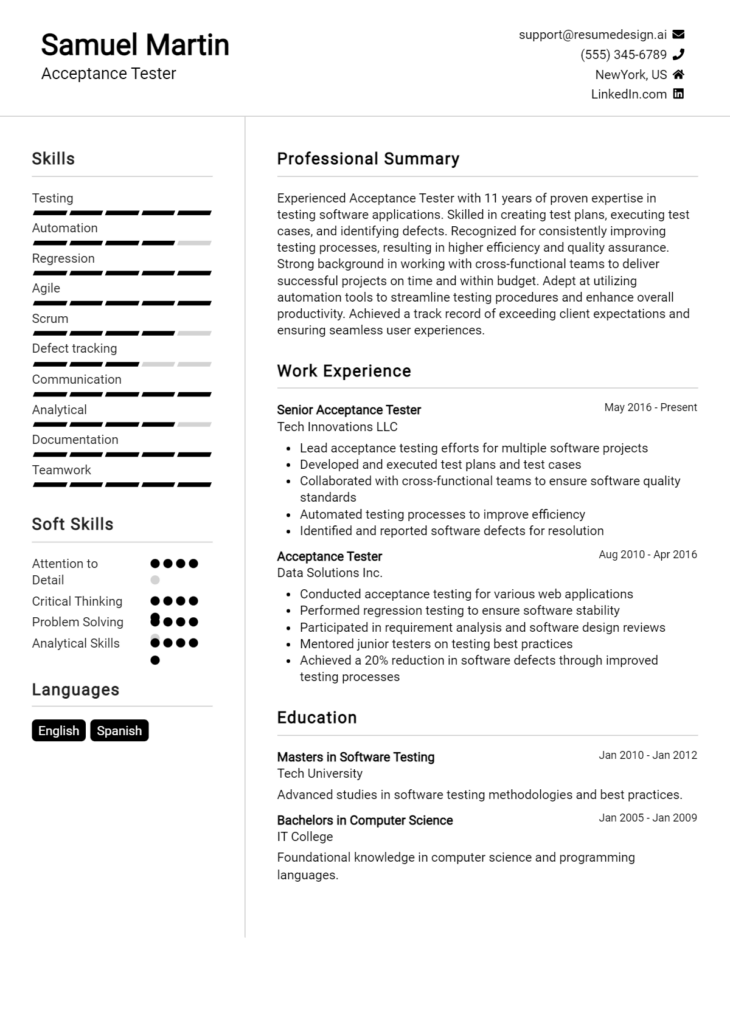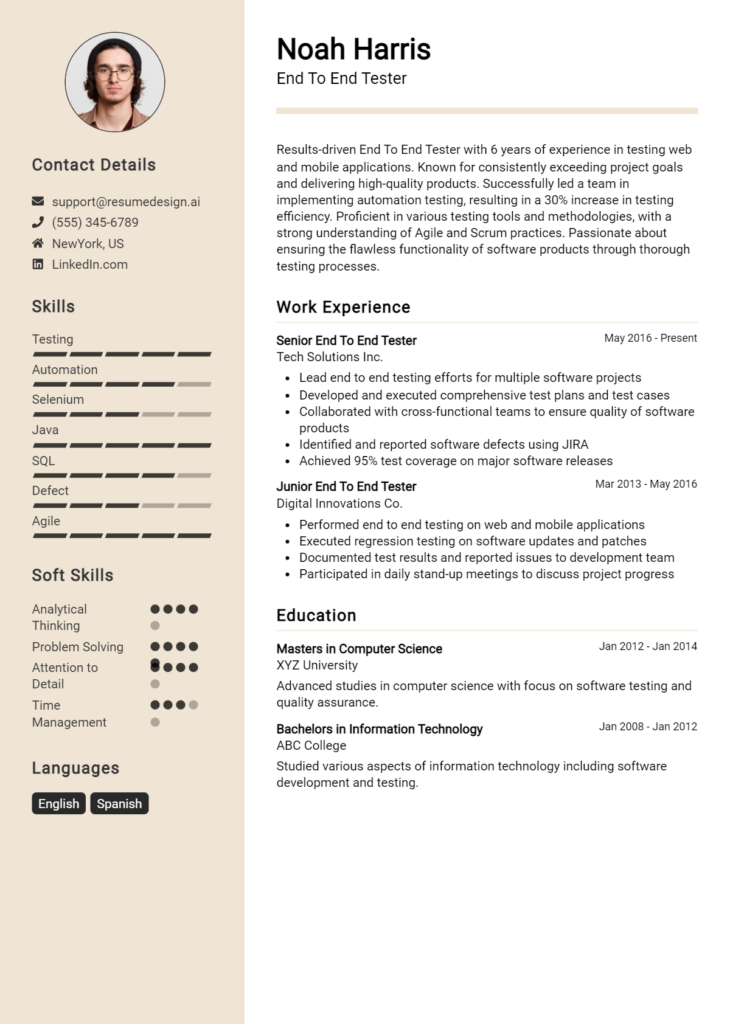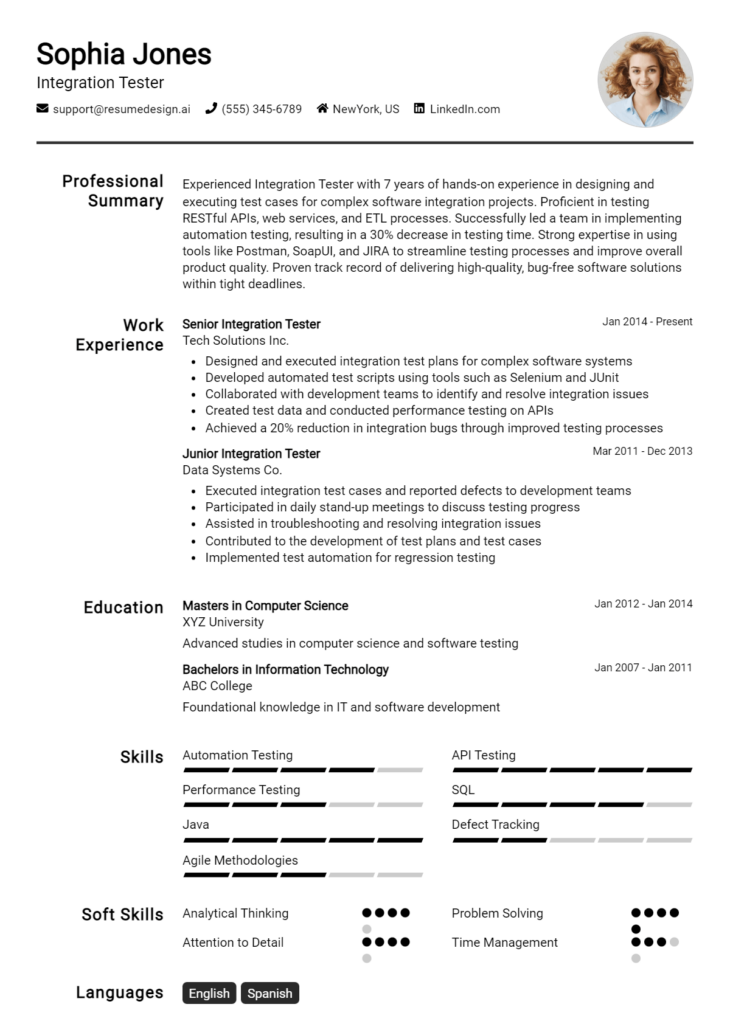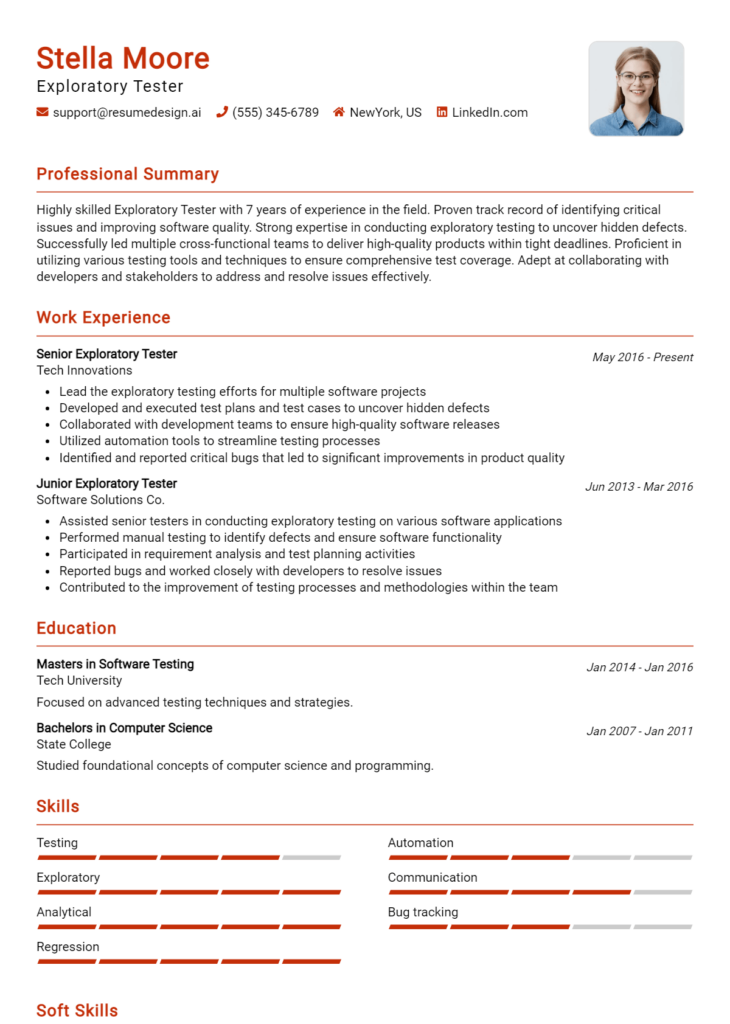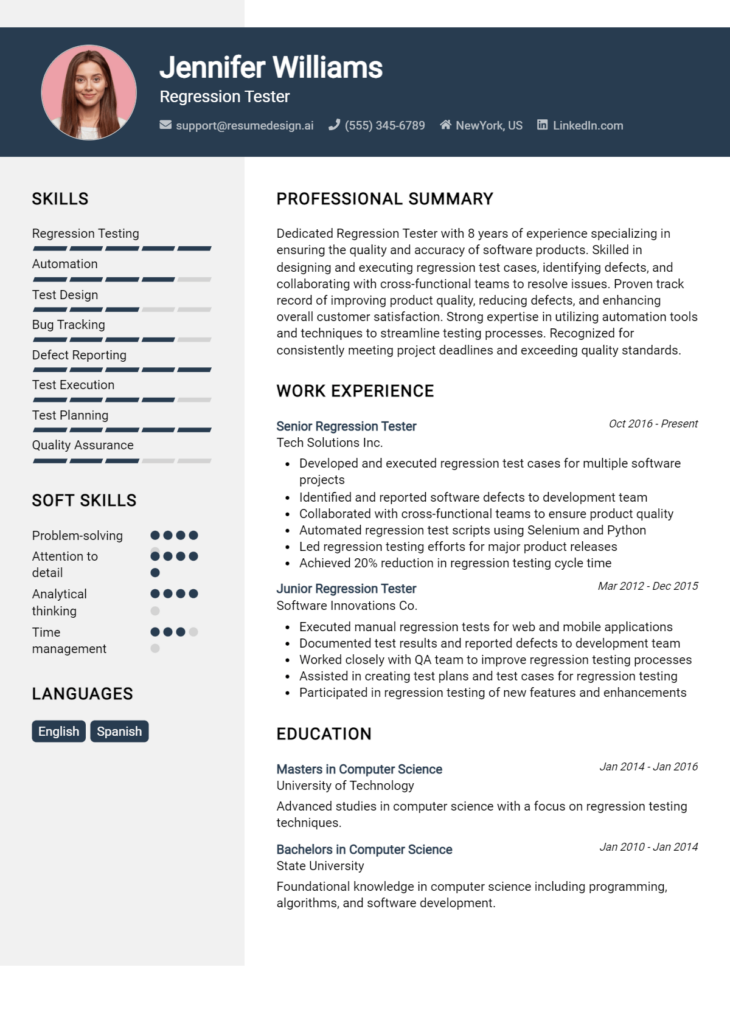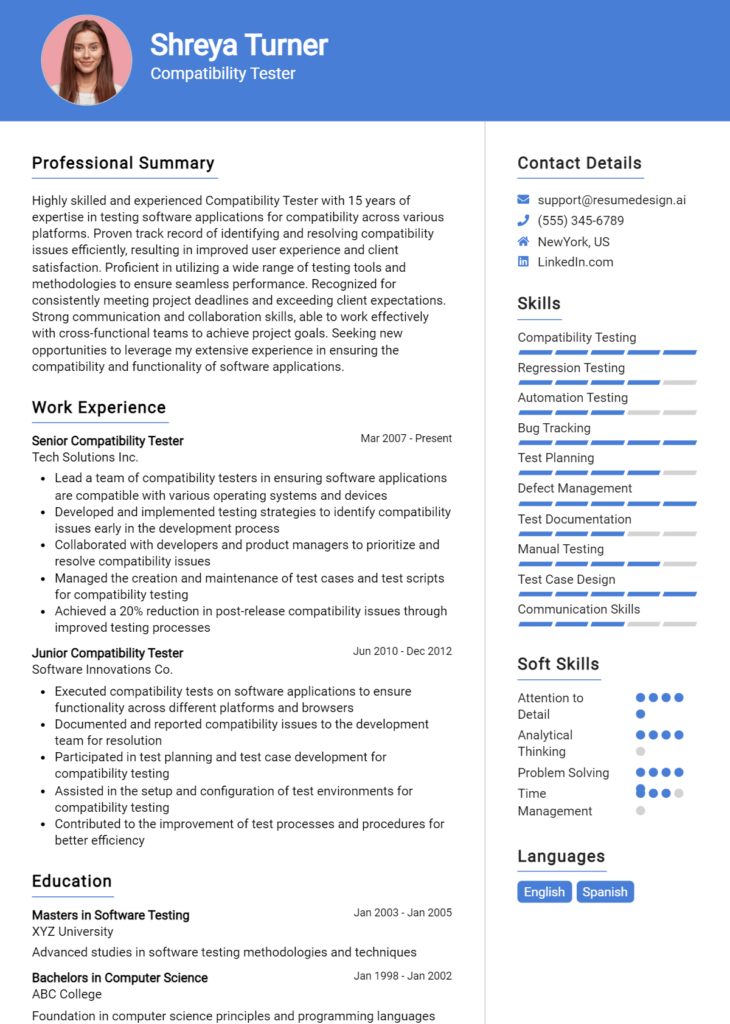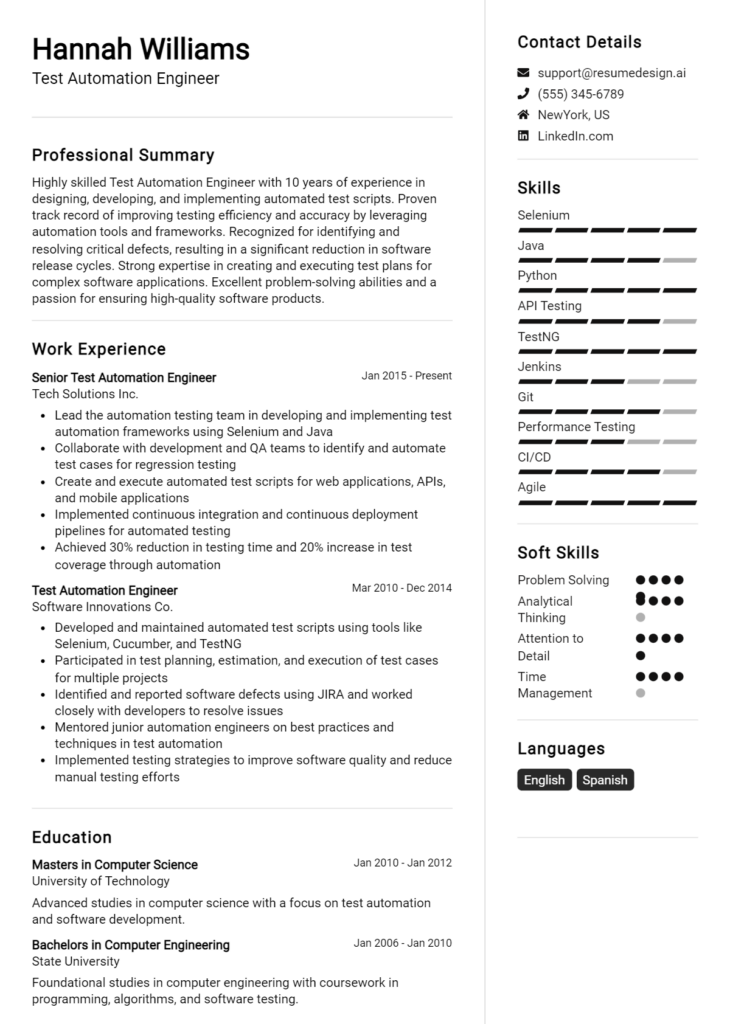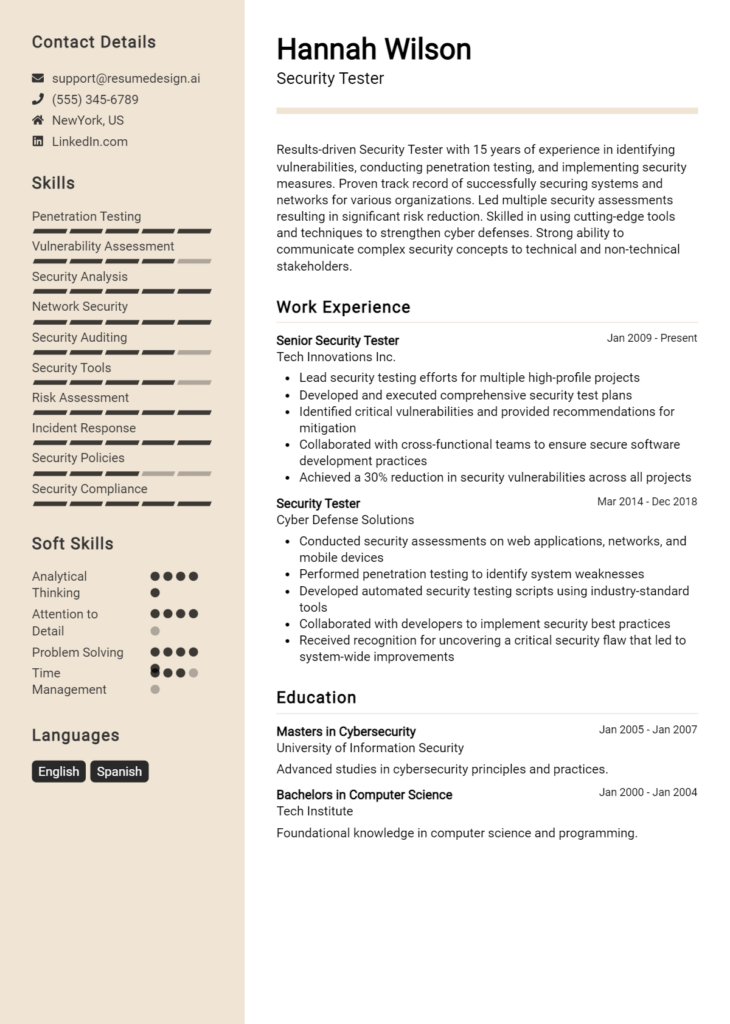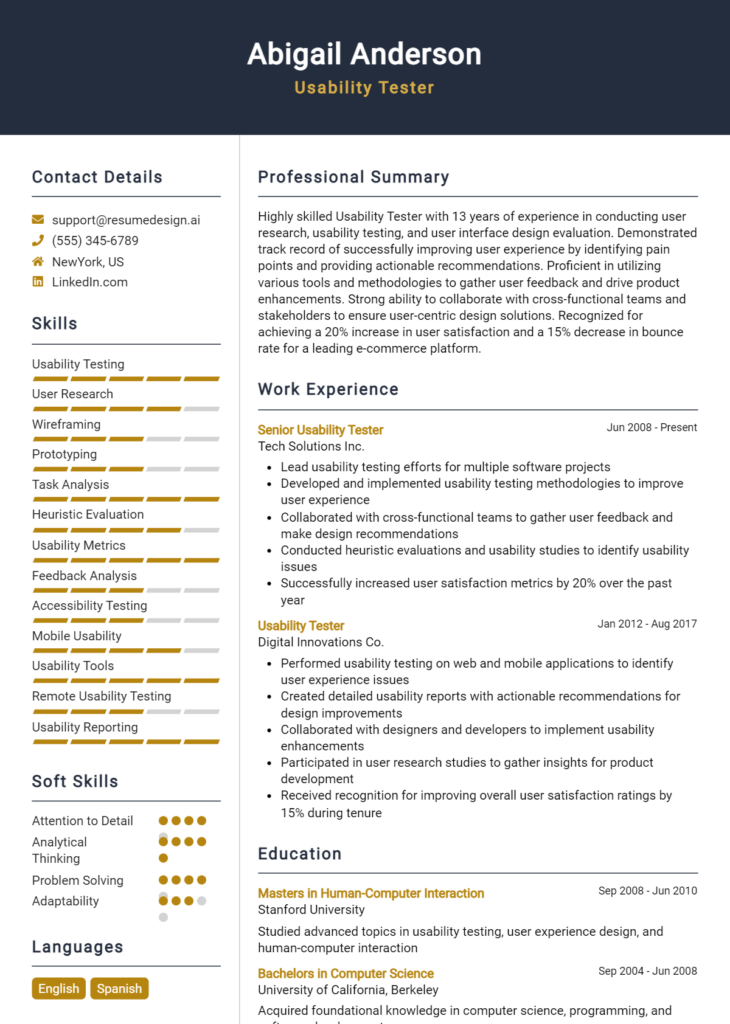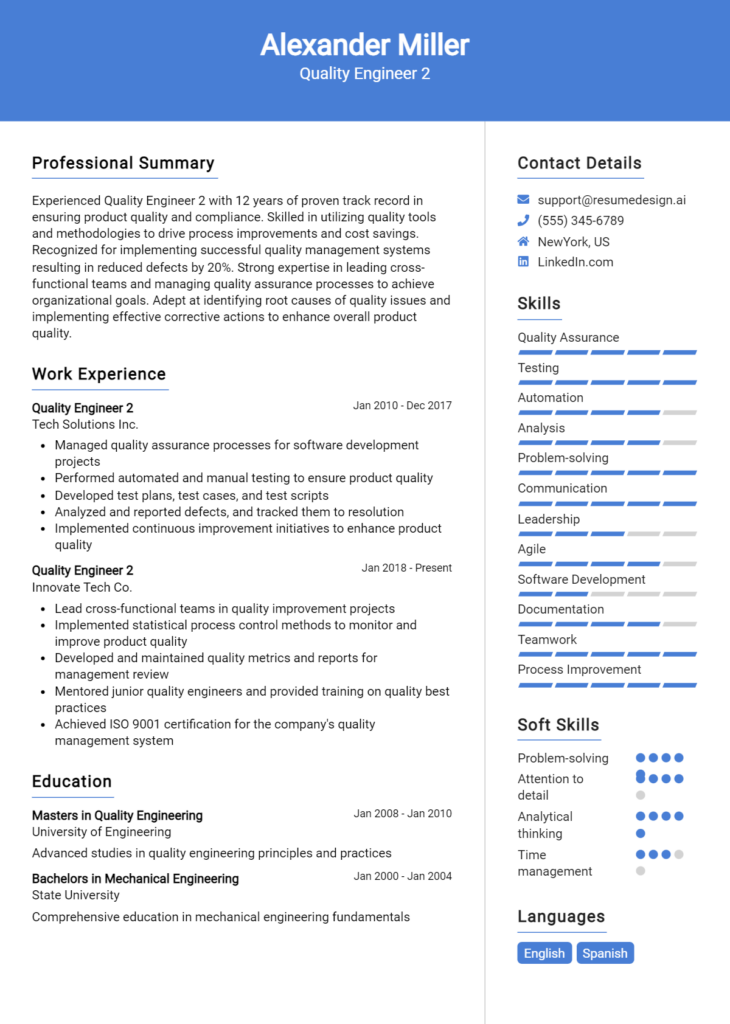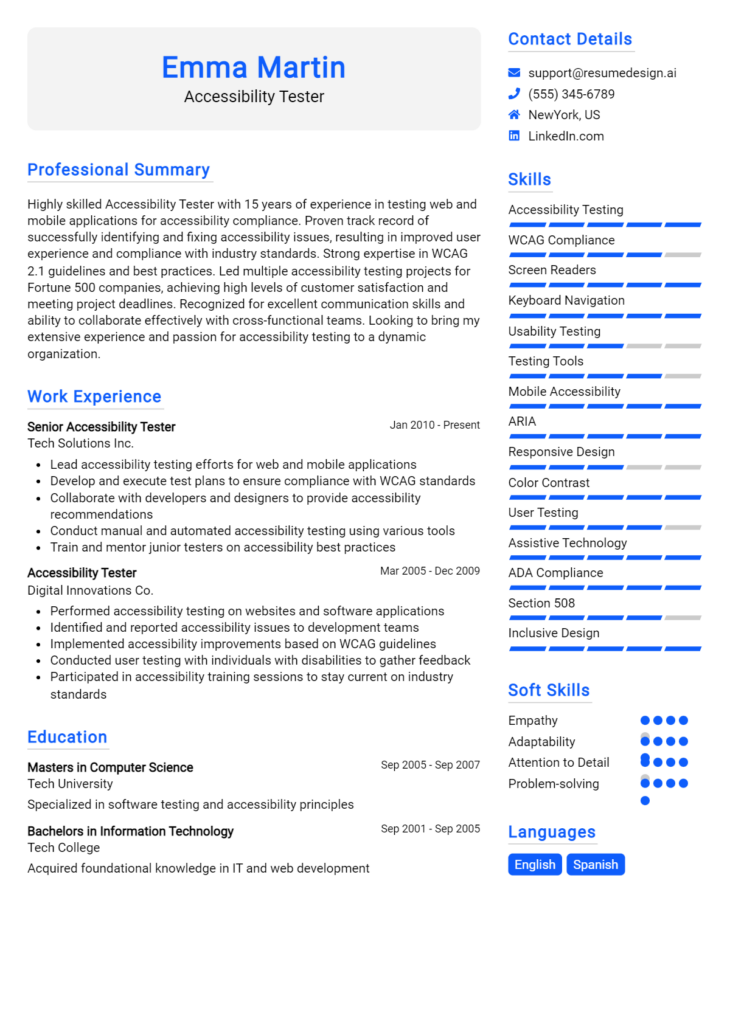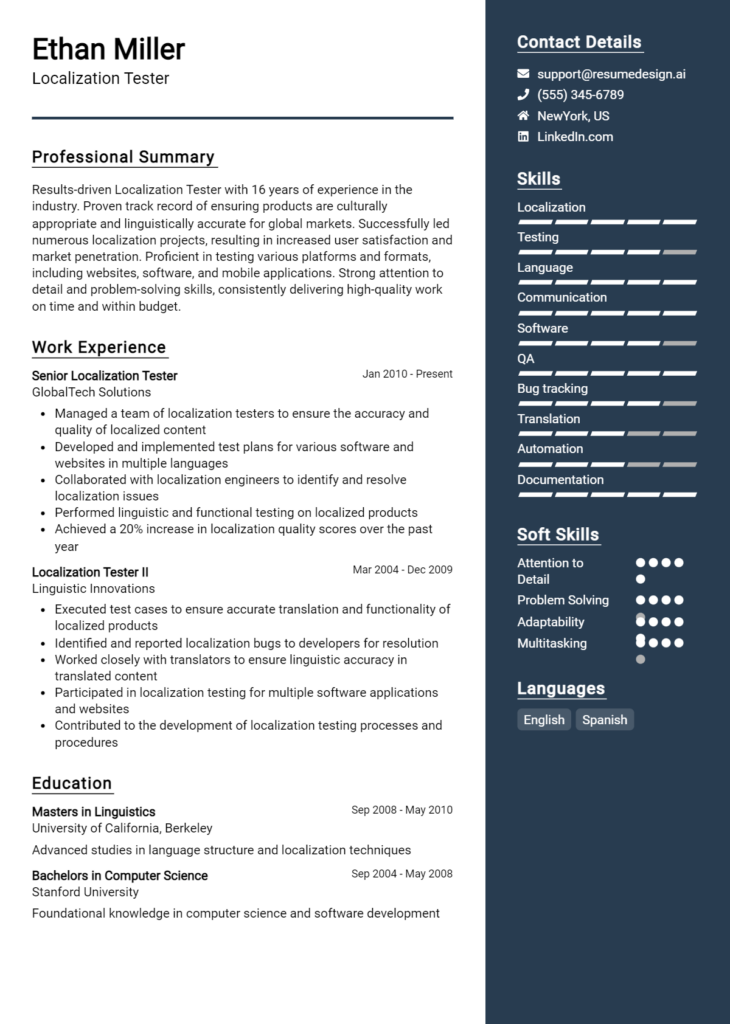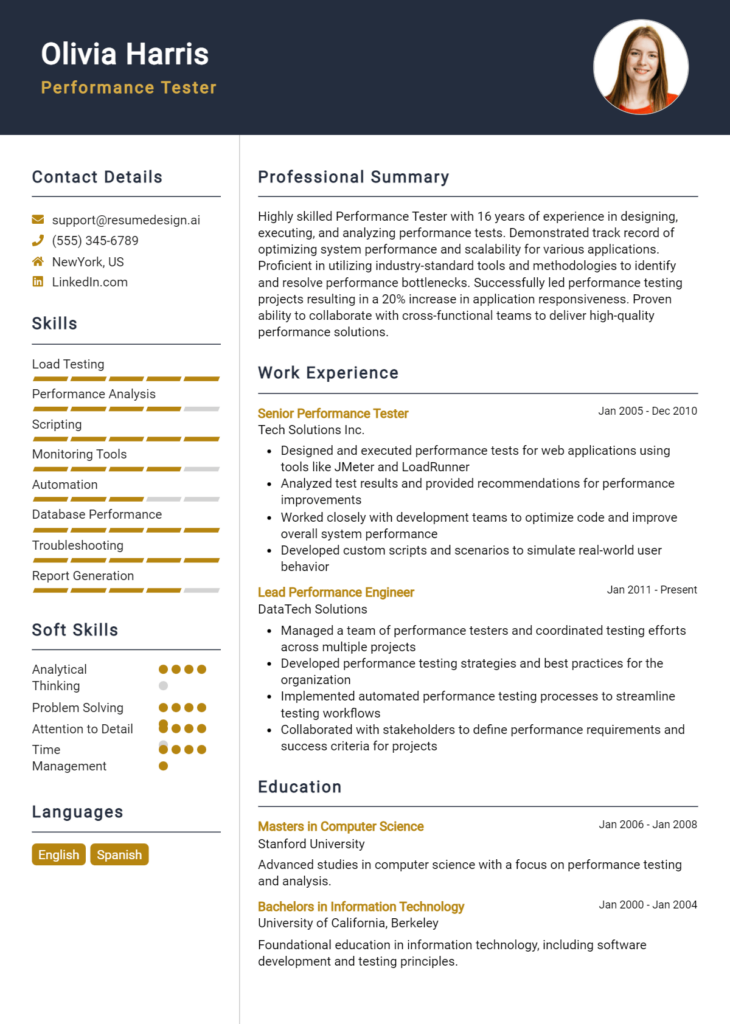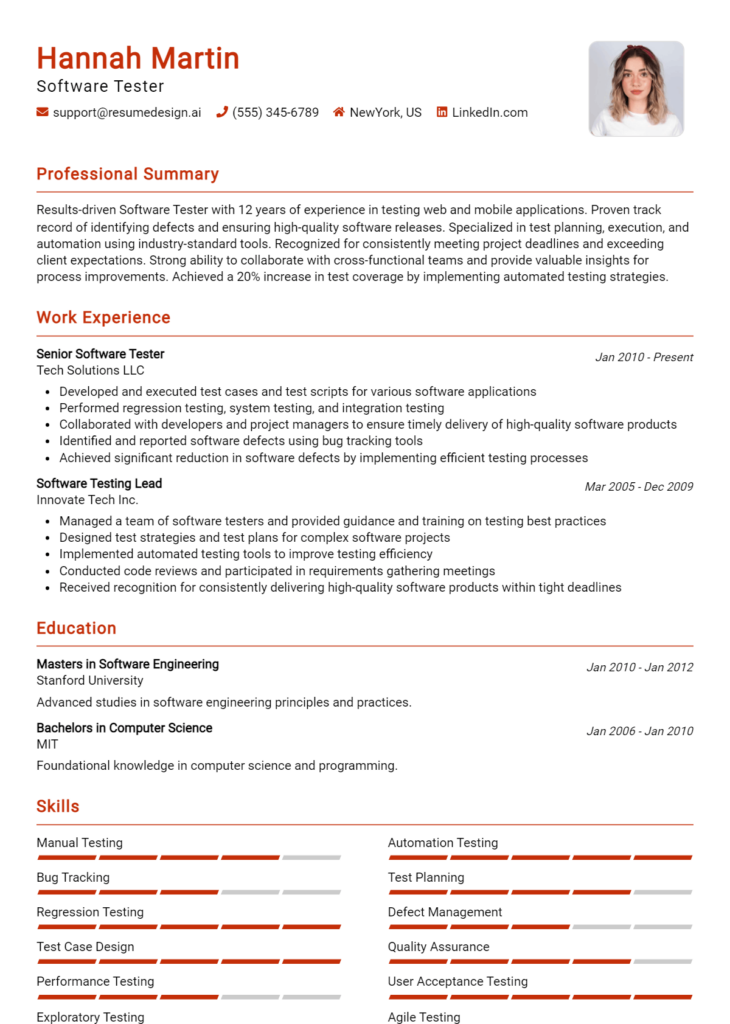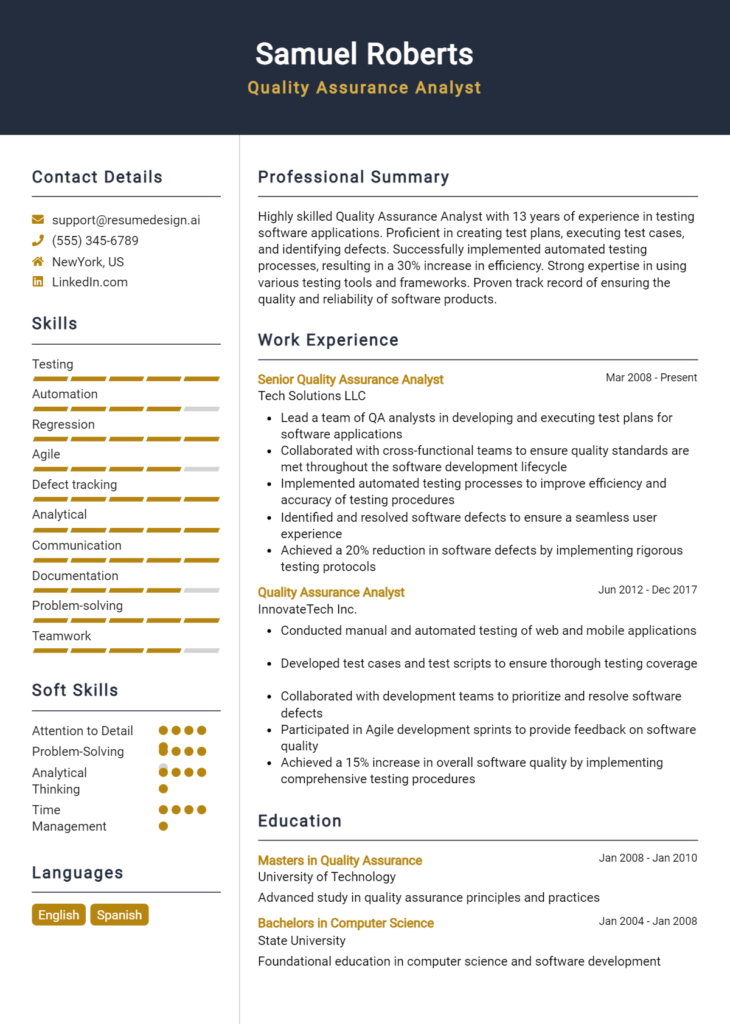Sanity Tester Core Responsibilities
A Sanity Tester plays a crucial role in ensuring software quality by validating that recent changes work as intended without introducing new defects. Core responsibilities include executing sanity tests, documenting results, and collaborating with development, QA, and product teams to facilitate smooth project transitions. Essential skills encompass technical acumen in testing tools, operational awareness of project workflows, and strong problem-solving capabilities. These competencies significantly contribute to the organization's overall goals by enhancing product reliability and stakeholder satisfaction. A well-structured resume can effectively showcase these qualifications, illustrating the candidate's value to potential employers.
Common Responsibilities Listed on Sanity Tester Resume
- Conducting sanity checks on new software builds.
- Reporting and documenting defects and issues.
- Collaborating with QA and development teams for effective testing.
- Validating functionality after bug fixes or enhancements.
- Creating and maintaining test case documentation.
- Participating in requirement reviews and design discussions.
- Providing feedback on software usability and performance.
- Assisting in the development of testing strategies and plans.
- Tracking and analyzing test results for decision-making.
- Ensuring compliance with quality standards and methodologies.
- Communicating test progress and results to stakeholders.
High-Level Resume Tips for Sanity Tester Professionals
In the competitive landscape of software testing, a well-crafted resume is essential for Sanity Tester professionals. This document serves as the first impression a candidate makes on potential employers, making it crucial to reflect not only technical skills but also notable achievements. A compelling resume should effectively convey a candidate's qualifications and experience, showcasing their ability to ensure software quality through thorough testing processes. This guide will provide practical and actionable resume tips specifically tailored for Sanity Tester professionals, helping to enhance your chances of standing out in the job market.
Top Resume Tips for Sanity Tester Professionals
- Tailor your resume to the job description by incorporating relevant keywords and phrases that align with the specific requirements of the position.
- Highlight your relevant experience, focusing on previous roles in quality assurance or software testing, and specifying the types of tests you have conducted.
- Quantify your achievements by including metrics, such as the percentage of bugs identified before release or improvements in testing efficiency.
- Showcase industry-specific skills, such as familiarity with automated testing tools, test case development, and defect tracking software.
- Include certifications related to software testing, such as ISTQB or CSTE, to establish your credibility and commitment to the profession.
- Use a clean, professional format with clear headings and bullet points to enhance readability and draw attention to key information.
- Incorporate a summary statement at the beginning of your resume that succinctly encapsulates your experience and strengths as a Sanity Tester.
- List relevant technical skills, including programming languages, testing frameworks, and any experience with Agile or DevOps methodologies.
- Provide examples of collaboration with development teams to demonstrate your ability to communicate effectively and contribute to a cohesive workflow.
By implementing these tips, Sanity Tester professionals can significantly enhance their resumes, increasing their chances of landing a job in this field. A well-structured and targeted resume not only showcases your qualifications but also reflects your dedication and professionalism, making you a strong candidate in the competitive job market.
Why Resume Headlines & Titles are Important for Sanity Tester
In the competitive field of software testing, the role of a Sanity Tester is crucial for ensuring that software applications meet the necessary quality standards before they are released. A well-crafted resume headline or title acts as a powerful first impression, allowing candidates to succinctly convey their expertise and suitability for the position. A strong headline captures the attention of hiring managers by summarizing the candidate's key qualifications in one impactful phrase, thereby increasing the likelihood of the resume being noticed. It should be concise, relevant, and directly tied to the specific requirements of the job being applied for, helping to set the tone for the rest of the resume.
Best Practices for Crafting Resume Headlines for Sanity Tester
- Keep it concise – Aim for one impactful sentence or phrase.
- Make it role-specific – Use keywords related to the Sanity Tester position.
- Highlight key strengths – Incorporate your most relevant skills or accomplishments.
- Avoid jargon – Use clear and straightforward language that anyone can understand.
- Use active language – Start with strong action verbs to convey confidence.
- Tailor for each application – Customize your headline for different job postings.
- Focus on achievements – Mention any notable projects or successes in testing.
- Maintain professionalism – Ensure the tone aligns with the industry standards.
Example Resume Headlines for Sanity Tester
Strong Resume Headlines
"Detail-Oriented Sanity Tester with 5+ Years of Experience in Agile Environments"
“Results-Driven Software Quality Assurance Specialist Focused on Efficient Sanity Testing”
“Proficient Sanity Tester with Expertise in Automated Testing Tools and Methodologies”
Weak Resume Headlines
“Looking for a Job in Testing”
“Test Engineer”
The strong headlines are effective because they are specific, highlighting relevant experience and skills that resonate with hiring managers looking for a qualified Sanity Tester. They convey the candidate's value proposition in a way that is immediately clear and compelling. In contrast, the weak headlines fail to impress due to their vagueness and lack of focus, failing to communicate any particular strengths or qualifications that would differentiate the candidate from others in the field.
Writing an Exceptional Sanity Tester Resume Summary
A well-crafted resume summary is crucial for a Sanity Tester, as it serves as the first impression for hiring managers. This brief yet powerful introduction succinctly highlights key skills, relevant experience, and notable accomplishments, ensuring that the candidate stands out among a sea of applicants. A strong summary not only captures attention but also sets the tone for the rest of the resume, making it essential to be concise, impactful, and tailored to the specific job being applied for. By doing so, candidates can effectively communicate their suitability for the role and increase their chances of securing an interview.
Best Practices for Writing a Sanity Tester Resume Summary
- Quantify Achievements: Use specific numbers or percentages to demonstrate your impact in previous roles.
- Focus on Skills: Highlight key technical skills relevant to sanity testing, such as automation tools or testing methodologies.
- Tailor to Job Description: Customize your summary to align with the specific requirements and responsibilities of the job you are applying for.
- Keep it Concise: Aim for 2-4 sentences that deliver the most important information without being overly verbose.
- Use Action Words: Start sentences with strong action verbs to convey confidence and proactivity.
- Showcase Relevant Experience: Mention your years of experience in quality assurance and any specific industries you've worked in.
- Include Certifications: If applicable, briefly mention relevant certifications that enhance your candidacy.
- Highlight Problem-Solving Skills: Emphasize your ability to identify issues quickly and effectively in testing processes.
Example Sanity Tester Resume Summaries
Strong Resume Summaries
Detail-oriented Sanity Tester with over 5 years of experience in software quality assurance. Successfully reduced testing time by 30% through the implementation of automated testing tools, resulting in a 20% increase in team efficiency.
Results-driven QA professional specializing in sanity testing for web applications. Proven track record of identifying critical issues pre-release, contributing to a 40% decrease in post-launch defects, ensuring seamless user experiences.
Certified Software Tester with extensive knowledge of manual and automated testing methodologies. Played a key role in a cross-functional team that enhanced product quality, leading to a 50% increase in customer satisfaction ratings.
Proficient in sanity testing with a strong background in Agile environments. Leveraged testing frameworks to streamline processes, achieving a 15% reduction in time-to-market for multiple software releases.
Weak Resume Summaries
QA Tester with experience in testing various applications. I am looking for a challenging role in a reputable company.
Detail-oriented professional interested in a position related to software testing. I am a quick learner and can adapt to new environments.
The examples of strong resume summaries effectively demonstrate specific achievements, quantifiable outcomes, and relevant skills that directly align with the Sanity Tester role. They provide clear insights into the candidate's ability to contribute to the organization. In contrast, the weak summaries lack specificity and measurable results, making them less effective in capturing the attention of hiring managers. They come across as generic and do not showcase the candidate's true potential or relevance to the position.
Work Experience Section for Sanity Tester Resume
The work experience section of a Sanity Tester resume is vital as it provides a platform for candidates to demonstrate their technical skills, leadership capabilities, and commitment to delivering high-quality products. This section serves as a testament to a candidate's hands-on experience in testing environments, showcasing their proficiency in identifying and rectifying issues swiftly. By quantifying achievements and aligning experiences with industry standards, candidates can effectively communicate their value to potential employers, proving their ability to contribute meaningfully to a team's success.
Best Practices for Sanity Tester Work Experience
- Highlight specific technical skills relevant to sanity testing, such as familiarity with testing tools and methodologies.
- Quantify achievements by using metrics, such as the percentage of bugs identified or the reduction in testing time.
- Demonstrate collaboration by mentioning projects worked on with cross-functional teams, including developers and product managers.
- Use action verbs to describe responsibilities and accomplishments, making statements more impactful.
- Align experiences with industry standards by referencing best practices in testing and quality assurance.
- Include certifications or training that enhance your credibility as a tester.
- Tailor your work experience to the job description, emphasizing relevant skills and accomplishments.
- Provide context for your achievements, detailing the challenges faced and how you overcame them.
Example Work Experiences for Sanity Tester
Strong Experiences
- Led a team of 5 testers in executing sanity tests for a major software release, resulting in a 30% reduction in post-release defects.
- Implemented automated sanity testing procedures that increased testing efficiency by 40%, allowing for faster release cycles.
- Collaborated with development teams to identify and resolve critical bugs, improving overall product stability and user satisfaction scores by 25%.
- Trained new team members on best practices in sanity testing, fostering a culture of quality assurance within the organization.
Weak Experiences
- Performed various testing tasks as assigned without specifying the type of testing.
- Worked in a team environment to ensure software quality.
- Participated in projects that involved testing software applications.
- Helped to identify bugs and issues in software during testing phases.
The examples listed above illustrate the difference between strong and weak experiences in a Sanity Tester resume. Strong experiences are characterized by specific, quantifiable outcomes that highlight leadership, collaboration, and technical expertise. They provide clear evidence of the candidate's impact on the product and the team. In contrast, weak experiences lack detail and measurable results, making it difficult for potential employers to assess the candidate's contributions or skills. Focusing on concrete achievements and responsibilities can significantly enhance the effectiveness of a resume.
Education and Certifications Section for Sanity Tester Resume
The education and certifications section of a Sanity Tester resume plays a vital role in establishing the candidate's qualifications and expertise in the field. This section not only highlights the candidate's academic background but also showcases their commitment to professional development through industry-relevant certifications and continuous learning. By including pertinent coursework, certifications, and specialized training, candidates can significantly enhance their credibility and demonstrate their alignment with the requirements of the job role, making them more appealing to potential employers.
Best Practices for Sanity Tester Education and Certifications
- List degrees and certifications in reverse chronological order to highlight the most recent qualifications first.
- Include only relevant coursework that pertains directly to testing, software quality assurance, or related fields.
- Highlight advanced certifications from recognized organizations, such as ISTQB or CSTE, to showcase expertise.
- Consider adding any specialized training that demonstrates proficiency in testing tools or methodologies.
- Use clear and concise language to describe each qualification, avoiding unnecessary jargon.
- Ensure that all certifications are current; consider renewing expired certifications to maintain relevance.
- Tailor the education and certifications section to reflect the requirements of the specific job being applied for.
- Include GPA or honors, if applicable, to enhance academic credentials, especially for recent graduates.
Example Education and Certifications for Sanity Tester
Strong Examples
- Bachelor of Science in Computer Science, University of Technology, 2022
- Certified Software Tester (CSTE), Quality Assurance Institute, 2023
- ISTQB Certified Tester, Foundation Level, 2023
- Coursework: Software Testing Methodologies, Agile Development Practices
Weak Examples
- Bachelor of Arts in History, University of Arts, 2019
- Certification in Basic Computer Skills, 2018
- Online Course: Introduction to Painting, 2021
- High School Diploma, 2015
The strong examples are considered effective because they are directly relevant to the role of a Sanity Tester, showcasing a background in computer science and recognized testing certifications that validate the candidate's skills. In contrast, the weak examples are ineffective as they include degrees and certifications that do not relate to software testing or quality assurance, indicating a lack of focus on the necessary qualifications for the role.
Top Skills & Keywords for Sanity Tester Resume
A well-crafted resume is essential for any Sanity Tester, as it serves as the first impression to potential employers. Highlighting the right skills can significantly enhance your candidacy, showcasing your ability to ensure software quality and functionality. A strong combination of both hard and soft skills is crucial in this role. Hard skills demonstrate your technical proficiency, while soft skills reflect your ability to communicate, collaborate, and adapt in a dynamic work environment. By strategically incorporating these skills into your resume, you can better illustrate your qualifications and align with the expectations of hiring managers in the software testing industry.
Top Hard & Soft Skills for Sanity Tester
Soft Skills
- Attention to Detail
- Problem-Solving
- Effective Communication
- Time Management
- Analytical Thinking
- Team Collaboration
- Adaptability
- Critical Thinking
- Conflict Resolution
- Creativity
Hard Skills
- Knowledge of Testing Tools (e.g., Selenium, JIRA)
- Understanding of Software Development Life Cycle (SDLC)
- Familiarity with Test Case Design
- Proficiency in Bug Tracking and Reporting
- Experience with Automation Testing
- Basic Knowledge of Programming Languages (e.g., Java, Python)
- Database Testing Skills (SQL)
- Familiarity with Agile Methodologies
- Performance Testing Techniques
- Understanding of Usability Testing
Incorporating these skills into your resume can enhance your profile, while also ensuring you highlight relevant work experience that demonstrates these capabilities in action.
Stand Out with a Winning Sanity Tester Cover Letter
Dear Hiring Manager,
I am writing to express my interest in the Sanity Tester position at [Company Name] as advertised on [Job Board/Company Website]. With a solid background in software testing and a keen eye for detail, I am well-prepared to contribute effectively to your quality assurance team. My experience in conducting sanity tests has equipped me with the skills necessary to ensure that software products meet the required functionality before progressing to more rigorous testing phases.
In my previous role at [Previous Company Name], I successfully executed sanity tests on multiple applications, identifying critical issues that could have escalated into larger problems if left unchecked. My systematic approach to testing, combined with my ability to quickly understand new software functionalities, allowed me to deliver accurate and timely feedback to the development team. Furthermore, my collaboration with cross-functional teams has enhanced my communication skills, ensuring that I can articulate testing outcomes clearly and effectively.
I am particularly drawn to [Company Name] because of your commitment to innovation and excellence in software development. I am eager to bring my expertise in sanity testing to your team, ensuring that every product release aligns with your high standards of quality. I am confident that my proactive approach and passion for testing will make a valuable contribution to your organization.
Thank you for considering my application. I look forward to the opportunity to discuss how my background and skills align with the needs of [Company Name]. I am excited about the possibility of joining your team and contributing to the success of your projects.
Sincerely,
[Your Name]
[Your Contact Information]
Common Mistakes to Avoid in a Sanity Tester Resume
When crafting a resume as a Sanity Tester, it's crucial to present your skills and experience effectively to stand out to potential employers. However, many candidates make common mistakes that can undermine their qualifications and leave a negative impression. By avoiding these pitfalls, you can enhance your resume and increase your chances of landing an interview. Here are some key mistakes to watch out for:
Vague Job Descriptions: Failing to provide specific details about your previous roles can make it difficult for hiring managers to assess your relevant experience. Always include quantifiable achievements and specific tasks you performed.
Ignoring Keywords: Many companies use applicant tracking systems (ATS) to filter resumes. Not incorporating relevant keywords from the job description can result in your resume being overlooked.
Overloading with Technical Jargon: While it’s important to showcase your technical skills, using too much jargon can confuse the reader. Aim for clarity and conciseness in your descriptions.
Neglecting Soft Skills: Sanity testing isn't just about technical abilities; soft skills like communication and teamwork are equally important. Failing to highlight these can give an incomplete picture of your capabilities.
Inconsistent Formatting: A cluttered or inconsistent format can detract from the professionalism of your resume. Use a clean, uniform layout to make it easy for employers to read.
Lack of Customization: Sending out a generic resume for every application fails to highlight your fit for the specific role. Tailoring your resume to align with the job requirements shows genuine interest and effort.
Omitting Relevant Certifications: If you have relevant certifications (like ISTQB or others), not including them can be a missed opportunity to showcase your commitment to the profession.
Errors and Typos: Simple mistakes can make you appear careless or unprofessional. Always proofread your resume to eliminate any spelling or grammatical errors before submission.
Conclusion
As a Sanity Tester, you play a critical role in ensuring that software applications function correctly after changes have been made. Your responsibilities include validating that new features and bug fixes work as intended while confirming that existing functionality remains unaffected. The position requires a keen eye for detail, strong analytical skills, and the ability to communicate effectively with development teams.
In this article, we discussed the various skills and qualifications necessary for a successful career as a Sanity Tester. Key points included the importance of understanding testing methodologies, familiarity with various testing tools, and the ability to write clear and concise test cases. Additionally, we highlighted the value of continuous learning and staying updated with industry trends to enhance your expertise.
To stand out in this competitive field, it's essential to have a well-crafted resume that showcases your skills and experience effectively. We encourage you to review your Sanity Tester resume and make any necessary updates to reflect your qualifications accurately.
To assist you in this process, we recommend utilizing the following resources:
- Explore resume templates to find a design that suits your style.
- Use the resume builder for an easy and efficient way to create a professional resume.
- Check out resume examples for inspiration on how to format and phrase your experiences.
- Don’t forget to craft a compelling cover letter using our cover letter templates to make a great first impression.
Take action now and elevate your resume to secure your next opportunity as a Sanity Tester!

